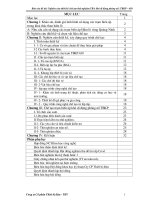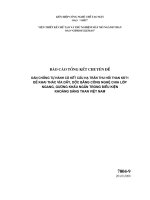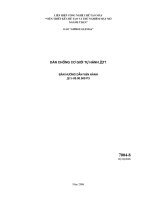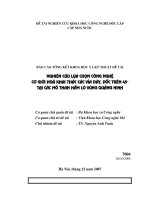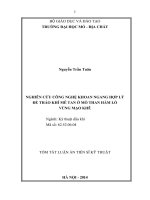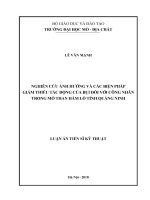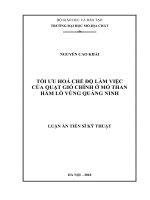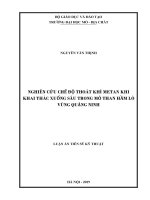Nghiên cứu chế độ thoát khí metan khi khai thác xuống sâu trong mỏ than hầm lò vùng quảng ninh TOM TAT LATS t a
Bạn đang xem bản rút gọn của tài liệu. Xem và tải ngay bản đầy đủ của tài liệu tại đây (1.28 MB, 23 trang )
THE MINISTRY OF EDUCATION AND TRAINING
HANOI UNIVERSITY OF MINING AND GEOLOGY
-----------------------------------
NGUYEN VAN THINH
RESEARCH ON METHANE DRAINAGE REGIME WHEN EXPLOITING
TO DEEP IN UNDERGROUND COAL MINES IN QUANG NINH AREA
Specializ: Mining
Code: 9520603
SUMMARY OF TECHNICAL DOCTORAL THESIS
HANOI - 2019
Thesis is finished at Department of Underground mining, Faculty Mines,
Ha Noi University of Mining and Geology
Scientific advisors:
1. Assoc.Prof.Dr Dang Vu Chi, Hanoi University of mining and
geology
2. Dr Le Van Thao, Vietnam Mining Science and Technology
Association
Reporter 1: Prof.Dr.Sc Le Nhu Hung, Vietnam Mining Science and
Technology Association;
Reporter 2: Dr Nguyen Anh Tuan, Vietnam National coal and mineral
industries holding Corporation limited;
Reporter 3: Dr Dao Hong Quang, Vinacomin Institute of Mining Science
anh Technology.
The thesis will be defended before the school level of thesis jury
in Ha Noi University of Mining and Geology
at……………………2019
The thesis can be found at:
- National Library;
- Library of the University of Mining and Geology
3
MỞ ĐẦU
1. Necessity of thesis
According to the Decision No. 403 / QD-TTg dated March 14, 2016 of
the Prime Minister on approving the adjustment of the development planning of
Vietnam's coal industry to 2020, considering the prospects until 2030, at Article
1, Section II.2.b states "The volume of commercial coal produced in the
industry in the planning stages: About 41 - 44 million tons in 2016; 47-50
million tons by 2020; 51 - 54 million tons in 2025 and 55-57 million tons in
2030 ".
In order to meet the requirements for the output of pit coal mines, it is
increasingly necessary to go deep, expand the scale as well as apply
mechanization in mining and digging. The increase in coal production leads to
the amount of methane being released to the ovens and the furnace to prepare
more and more. Methane is a gas that can cause very dangerous explosions.
In the history of pit coal mining in the world and in Vietnam, there have been
many CH4 gas explosions that have killed dozens, even hundreds, of people and
destroyed the facilities of coal mines. Due to the dangerous nature of methane
released in the pit of mines causing the risk of fire and explosion, the coal mining
industry in the world as well as in Vietnam always put the issue of methane fire
prevention and fighting on top, including the study of methane drainage and methane
storage in coal seams is the source of the release of methane gas into mine kilns.
In our country, the researches on gas storage and methane drainage have been
carried out for many years but mainly focused on mines with high gas emission, not
yet universal and have not been proposed. newspaper when exploiting deep into each
mineral deposit or underground coal mine to take measures to prevent gas
accumulation exceeding the effective permissible limit.
In order to assess the danger of methane for each coal mine or mining
area, it is necessary to determine the methane release mode of the mine or
mining area. Of particular importance is the study of determining the
containment of methane in coal seams and the degree of leaching of gases to
quantify mine kilns in a quantitative way to apply the method of exploiting and
using room facilities Suitable methane explosion protection and safety
guarantee and improve economic efficiency.
Therefore, "Research on methane drainage regime when exploiting to
deep in underground coal mine in Quang Ninh region" is urgent.
2. Research aim of thesis
- Study on methane drainage regime in underground coal mines in Quang
Ninh area when exploiting deeply.
- Proposing suitable solutions for preventing and combating methane fire
when exploiting in underground coal mines in Quang Ninh region.
4
3. Research objective and scope
Object of the study: Gas emission and methane content in coal seams
affect the mining process down to underground coal mines in Quang Ninh.
Scope of research: The topic is underground coal mines in Quang Ninh
4. Research content
- An overview of the study on the regime of methane drainage in pit coal
mines in the world and in Vietnam
- Study the characteristics of methane gas storage when exploiting deep in
coal seams of coal mines in Quang Ninh region
- Study the methane gas escape when exploiting deep in underground coal
mines in Quang Ninh region
- Study and propose suitable solutions to prevent methane fire and
explosion for underground coal mines in Quang Ninh.
5. Research Methods
The thesis uses a combination of the following research methods:
- Methods of surveying, synthesizing and inheriting documents;
- Methods of analysis, statistics and graph methods;
- Methods of linear interpolation and non-linearity.
6. Scientific and practical meaning of thesis
6.1. Scientific meaning:
- Develop regression functions using the least squares method to forecast
gas storage and methane release in underground coal mines in Quang Ninh
region;
- Predict the process of methane release into mining areas on the basis of
determining the level of methane drainage at the extraction level on her
forecasting methane drainage for the next extraction level.
6.2. Practical meaning: The research results contribute to the
determination and prediction of methane drainage and coal mining areas of coal
mines in Quang Ninh in the deep exploitation areas to take appropriate
measures to prevent methane explosion.
7. New points of thesis
- Constructing regression function on the methane gas storage in coal
seams in underground coal mines in Quang Ninh region with the form y = a.xb.
- Establish a map of methane zoning according to the scope and depth of
underground coal mines in Quang Ninh region
- Forecast of methane release for market ovens at underground coal mines
in Quang Ninh area, with actual measurement results by multiplying forecast
results with coefficient k = 0,9316 and plus 0.0029
8. Scientific thesis
- The deeper the mining, the higher the gas storage and methane release;
- Same geological condition, methane drainage depends on coal seam
thickness and mining output;
5
- For the system of mining and division of layers, the methane drainage in the
upper layer is greater than the escape of methane in the lower layer.
9. The thesis structure
The thesis consists of 4 chapters, Introduction sections and Conclusion
conclusions, pages, including drawings and tables.
Chapter 1
OVERVIEW OF METHODS TO STUDY METHANE DRAINAGE IN
UNDERGROUND COAL MINES IN THE WORLD AND VIETNAM
1.1. GENERAL CHARACTERISTICS OF METHANE
Methane (CH4) is the simplest type of saturated carbonate of paraffin group.
Colorless gas, odorless, tasteless. Its density in normal conditions is 0.716 kg /
m3, which is several times lighter than air. It is soluble in ethanol, ether, poorly
dissolved in water (up to 3.5% under normal conditions). Although methane is a
gas that does not affect respiration, significant concentrations in the air are
dangerous because methane gas pushes oxygen (4.8% methane will push 1%
oxygen). Methane is a potentially explosive gas. When the volume content of
methane is in the range of 5 - 15% and the minimum oxygen content of about
8% of the mixture is explosive, the explosive mixture is strongest when the
methane content reaches 9.5%. The explosion limit of methane is not fixed and
depends on the pressure, temperature, combustion position and initial heating
intensity. Under reduced pressure, the explosion limit will shrink. In the
direction of increasing temperature - the explosion limit will expand and vice
versa.
1.2. OVERVIEW OF METHODS TO STUDY METHANE DRAINAGE IN
UNDERGROUND COAL MINES IN THE WORLD
a. Methods in Western European countries
In Western European countries, people often use the method of
forecasting the methane escape into the oven by Shulza, Wintera and Stuffkena.
Inside:
M- Released gas relative to the longwall (m3CH4/T-ng.đ)
Wtn- Do contains natural gas of coal seams (m3CH4/T)
Wlc- Gas reservoir of nearby reservoir (m3CH4/T)
mlc- Thickness of adjacent seams; (m).
mkt- Thickness of exploitation seam
nlc - Number of air discharges from adjacent reservoirs (above or below),
this number depends on the distance from the adjacent seams to the existing
seams.
b. Statistical method of the Soviet Union
The basis of this method is the system of statistic data in the past in terms
6
of air discharge of the mining area or exploitation floor and other factors such
as extraction level and length of longwall. The accuracy of the method depends
on the reliability of the statistics. The methane emission of the new extraction
level is calculated according to the formula:
Inside:
Mp - The level of methane emission of the extraction level m3/Tngđ
H – Depth of new cascade level (m) (m)
H0- Depth of methane-containing cliff wall (m)
L- The gas-rich level indicates the depth increase so that the relative air
discharge increases by 1 m3CH4 / T-ng.đ; unit (m/m3CH4/T)
The value of the gas-rich level L is summarized from the statistics
collected at the already and exploited levels. The L value is determined by the
following formula:
H1- Exploitation depth of shallow level (m)
H2- Depth of exploitation of deeper level (m)
Mp1- The methane drainage is shallow (m3CH4/T-ng.đ)
Mp2- The methane drainage is deep (m3CH4/T-ng.đ)
For mines with many statistics of H1, H2 and different Mp1 Mp2 values, the
relationship between M- relative discharge and H- depth of exploitation can be
shown.
On the basis of the regular line M = f (H), we can predict the predicted
Mp gas discharge according to the depth value of the new exploitation level.
In this method, the higher the number of Mpi and Hi statistics, the higher
the forecast.
The drawback of the method is that there is a need for many statistical
figures over the years at different levels.
c. Method of forecasting the methane release from the extraction area of
experimental mine "Barbara", Poland
According to this method, the absolute solubility of methane released into
the oven is calculated according to the following general formula:
Vkt: Escape methane gas from coal mining, m3/ph
- Llc : Length of longwall,
m
- mkh : The thickness of the exploitation layer,
m
3
- Yv : Volumetric weight of coal in the seams T/m
- Wv : The content of methane in the coal seams
m3/ Tkhối cháy
7
- Vg: Methane gas escapes from the face of longwall
- Vtr: Methane gas escapes from above of the longwall
- Vdi: Methane gas escapes from the bottom of the longwall
- p - Mining speed of longwall,
m/ngđ
1.3. OVERVIEW OF METHODS TO STUDY METHANE DRAINAGE
UNDERGROUND COAL MINES IN VIETNAM
Research on methane drainage in Vietnam has been mentioned by a
number of authors such as Tran Tu Ba and Le Van Thao
Currently, in Vietnam is using the method of rigorous mine "Barbara" of
Poland to study the application of prediction of air discharge into a longwall
suitable for the conditions of Vietnamese underground coal mines because:
Geological and technological factors of Polish and Vietnamese
underground mines are not similar. Especially if talking about geologicalmining conditions, Poland's coal is energy coal (Bitumineous), while Vietnam
coal is coal-anthracite (Anthracite). The coal seams of Poland are quite deep
(thousands of meters) and most of them are curb. The coal seams in Quang
Ninh area are mostly steep ones, which are closer to the ground (currently, the
deepest coal mine in Vietnam is Khe Cham II-IV coal mine is expected to reach
-500 and will produce output in 2022). For that reason, it is necessary to
calculate and control the actual measurement results to be able to propose
adjustment coefficients to suit the geological conditions of underground mines
in Quang Ninh area.
1.4. REVIEW CHAPTER 1
- Methane is a dangerous gas for coal mines exploited by pit method
because this gas appears regularly in coal mines (especially mines of anthracite
and anthracite coal as in Quang Ninh area). ) and when a methane explosion
occurs, it often causes great loss of life and property and affects the mine
production.
- The demand for coal in the world as well as in Vietnam is increasing. At
the same time, the coal output exploited by pit method is increasing in
proportion to the exploitation by opencast method. Therefore, the issue of
ensuring the safety of methane fire in underground coal mines needs to be put
on top
- There are two main methods to study the storage and escape of methane
methane: Study on the storage and drainage of methane in the geological
exploration and study of the storage and drainage of methane in the extraction
process. In Vietnam Study the storage and drainage of methane during
geological exploration with little data, used to serve the initial mine design
work; Study on the storage and drainage of methane in the mining process used
to classify mines.
8
Chapter 2
CHARACTERISTICS OF METHANE CONTENT OF COAL SEAMS IN
UNDERGROUND COAL MINES IN QUANG NINH
2.1. GENERAL CHARACTERRISTICS OF METHANE STORAGE IN
COAL SEAMS
The concentration of methane is the amount of methane gas calculated
according to the standard conditions in 1 ton of combustion coal block.
The determinant of the level of methane containing coal deposits is the
closest tectonic change. Coal seams with conditions of methane accumulation
are usually the reservoirs below the gas-permeable layer of soil. The
phenomenon of gas-permeable coal seam layers does not create two types of
closed and open mineral forms. The level of each reservoir of methane gas in
the minerals depends on the existence of methane separation layers
The characteristic of closed type deposits is the coexistence of gaspermeable coal seam layers both in the covering soil layers and in carbon lava
layers alternating between coal seams. Thus the layers of this separation, the
shift of methane from the deeper layers slowed down. As the depth of
extraction increases, this type of mineral methane content increases and there is
a difference in each coal seams
2.2. GEOLOGICAL CHARATERISTICS OF QUANG NINH COAL AREA
Coal mines in Quang Ninh coal basin are affected by very strong bending
and fracturing activities, highly degraded coal. In Quang Ninh coal basin, there
are over 84.5% of coal mines belong to group III, only a few belong to group II
and mine group IV. However, the grouping of mines is essentially an average
value. Each coal mine has its own geometric fields in each high homogeneous
architectural block and has geometric anisotropic characteristics with different
anisotropic coefficients.
Within the coal basin, the sediments of the Hon Gai Formation have the
largest distribution area, concentrating into two large bands near the
longitudinal parallel between the area of Bao Dai and Pha Lai - Ke Bao.
Quang Ninh coal basin sediments are uniformly classified by geologists as
age (T3n - r) and named Hon Gai formation. The physical composition is
almost identical and the monotone repetition of the same rock layers in the
section, it is difficult to divide the stratigraphic and the cross-sectional
comparison only has relative meaning.
2.3. RESULTS OF DETERMINATION OF METHANE STORAGE IN COAL
SEAMS IN UNDERGROUND COAL MINES IN QUANG NINH
Table 1. Results of analysis of methane concentration in coal seams of
underground mines in Quang Ninh region
Name of coal
mines
Name of coal
seams
Level
The average value of
methane in coal
seams, m3/TKC
Note
9
1Cb
5
6
7
MaoKhe coal
mine
8
9
9b
10
50
-25
-70
-120
-150
-15
-59
-80
-100
-150
30
-25
-60
-80
-100
-150
-25
-50
-80
-120
-150
-25
-50
-80
-135
-150
30
-25
-57
-80
-120
-25
-58
-68
-80
-105
70
32
-25
-38
0.01787
0.311
0.32033
0.462
0.634
0.253
0.467
0.78
0.825
1.05
0.299
0.399
0.422
0.456
0.672
0.9582
0.366
0.938
1.01266
1.342
1.5785
0.367
0.52639
1.418
1.83364
1.988
0.356
0.698
1.389
2.26722
3.59497
0.1479
0.4141
0.8571
1.423
1.635
0.21066
0.289
0.375
0.661
10
10
HaLam coal
mine
11
14
12
KheCham
coal mine
13.1a
-80
-95
+10
+5
0
-10
-40
-46
-50
-65
-90
-150
0.936
1.029
0.061
0.0704
0.1131
0.1726
0.196817
0.24
0.2515
0.26385
0.2988
0.332
-200
0.37578
-46
-50
-70
-100
-110
-130
-145
-160
-250
+12
-25
-80
-90
-110
-150
-300
-120
-130
-140
-160
-180
-200
-110
-125
-130
-120
-163
0.01034
0.072
0.15
0.2311
0.25193
0.2745
0.262
0.2961
0.37494
0.105
0.192
0.208
0.217
0.239
0.272
0.35953
1.5
2.203
2.809
3.282
3.37104
3.916
2.263
3.53632
3.81109
3.976
4.8583
11
13.1
13.2
14.2
14.4
14.5
-200
-90
-100
-120
-130
-180
-225
-56
-100
-105
-120
-147
-152
-164
-190
-37
-45
-75
-80
-91
-94
-110
-124
-140
+69
-28
-45
-90
-100
-124
-150
-168
+59
+35
+3
-50
-71
-100
-140
5.302
3.37501
3.50684
4.758
4.827
5.02296
6.29
1.103
1.82
2.212
2.6
3.161
3.607
3.86856
4.148
1.522
2.19
2.386
2.661
3.114
3.14
3.66089
3.96833
4.2122
0.3064
0.38
0.8
1.055456
1.28536
1.21072
1.331
1.419
0.13684
1.0207
1.1666
1.19645
2.089
2.089
2.49023
12
2.4. STUDY THE RULES OF METHANE DISTRIBUTION
UNDERGROUND COAL MINES IN QUANG NINH
IN
The change of the reservoir depth of methane in the reservoir of Mao
Khe, Ha Lam and Khe Cham 1 mines is determined from the input data by the
empirical regression method based on the relationship y = a.x b and shown. on
the following picture:
Figure 1. Variation of methane gas content in coal seams of Mao Khe
Figure 2. Variation of methane gas content in coal seams of Ha Lam
13
Figure 3. Variation of methane gas content in coal seams of Khe Cham 1
From the graphs of the variation of methane gas in the depth of coal
seams, the methane gas content increases with the depth of the reservoir and the
methane gas content is in compliance with the regression function in the form
of y = a.xb with variables x is the depth (elevation) of coal seams, y is the level
of methane gas at depth x. Depending on specific conditions of each reservoir,
there are different values of a and b.
2.5. REVIEW CHAPTER 2
From the results of research on methane gas storage for coal seams of
mines The thesis has some following remarks:
- The content of methane gas increases with the depth of the reservoir as
well as the mine according to the rule y = a.xb
- In Quang Ninh coal basin, underground mines also divide into areas
with high methane content and lower methane gas storage area. Areas with high
levels of methane are shown in the mines: Mao Khe, Dong Vong, Quang Hanh,
Duong Huy, Khe Cham (class III and super class mines). The remaining coal
mines of Quang Ninh area have the methane content in low coal seams (mainly
mines of class I and II).
14
Chapter 3
STUDY ON THE REGIME OF METHANE DRAINAGE WHEN
EXPLOITING DEEPLY IN UNDERGROUND COAL MINES
IN QUANG NINH
3.1. STUDY ON METHANE DRAINAGE IN UNDERGROUND COAL
MINE IN QUANG NINH
To study the influence of geological factors affecting the escape of
methane in the furnace, it is necessary to select coal seams with different gas
concentrations, thus clearly reflecting the influence of gas storage. methane
dissolves in coal seams to escape methane gas into the oven of the mining
market. The author chooses 5 typical market ovens in the areas of Quang Ninh
coal region as follows.
Figure 4. Relationship between yield and absolute methane escape in MaoKhe
coal mine
15
Figure 5. Relationship between yield and absolute methane escape in HaLam
coal mine
Figure 6. Relationship between yield and absolute methane escape in Khe
Cham 1coal mine
16
Figure
7. Volume of methane gas released from underground coal mines
3.2. FORECAST OF METHANE DRAINAGE IN UNDERGROUND COAL
MINES IN QUANG NINH WHEN EXPLOITING DEEPLY
Based on the above analysis, the author selects Poland's method as the
basic method for research to apply in calculating the forecast of air discharge
into the furnace to suit the conditions of underground coal mines oven in
Vietnam
Figure 8. Each correlation between forecast results and actual
measurement results of methane escape
17
The results of the forecast calculation and the actual results of the actual
drainage of the long-term exhaust gas from the long-term market of companies
with high gas storage in each area of Mao Khe, Uong Bi, Hon Gai and Cam Pha
are presented. in the above table shows:
- The results of the forecast and the actual measurement results are not
much different, with the regression function by the method of minimum square
has the form: y=0,8651x +0,00246 with a deviation of R2=0,9896
Therefore, the forecasted results to apply in practice need to be multiplied
by the coefficient k = 0,8651x and plus 0,00246
- The results of the forecast of absolute air discharge of the areas are
generally higher than the actual measurement results.
3.3. REVIEW CHAPTER 3
The level of methane escape in the longwall, in the various technological
fluxes are subject to the general rule and the main dependence on methane gas
storage and the quantity of longwall mining is:
Relative methane emissions and methane emissions absolutely increase as
methane gas increases.
As mining output rises, the methane escaping is absolutely increasing, but
the relative emissions of methane are reduced.
From the above average combined results table shows that the methane
volume of the mines all tend to increase next year. On the other hand, mines are
exploited further and the output of exploitation does not increase much, so it is
said that when exploiting deeply, the amount of methane released from the
mining areas will increase.
Chapter 4
PROPOSING SOLUTIONS FOR PREVENTING METHANE FIRE AND
EXPLOSION IN UNDERGROUND COAL MINES IN QUANG NINH
4.1. MEASURES TO PREVENT DANGER FROM METHANE
4.1.1. Warning of the danger of methane by drilling the mirror for coal
digging ovens
18
Figure 9. Schematic layout of exploration drilling holes
4.1.2. Application of portable methane gas measuring devices
Figure 10. Image of measuring device, warning of portable methane gas
4.1.3. Application of automatic local monitoring system for high-risk
methane mines
Hình 11. Sơ đồ khối về hệ thống quan trắc
4.2. DYNAMIC MEASURES ELIMINATE THE DANGER OF METHANE
To actively eliminate the danger of methane it is necessary to lose the
escape of methane by drilling methane gas and discharging it outside the mine.
Longwall for drilling and removing methane is a coal mine of I-11-5 longwall, 11
seams, Khe Cham 1 coal mine, Ha Long-TKV coal company
Methane gas absorbed in boreholes through the pipeline system to
remove methane, to process methane gas, has 3 options to choose from.
* Option 1. Put methane gas on the ground and recover the gas for use;
* Option 2. Add methane gas to the ground and release the atmosphere;
19
* Option 3. Discharge the methane gas into the fan station ventilation
road.Currently, Khe Cham 1 coal mine is being exploited to -250 to -350, the
amount of methane released into the market is unstable so the flow and the
amount of methane can be unstable. Therefore, it is very costly to invest in the
system to absorb and process methane to be able to use it. So this topic will not
consider option 1.
Option 2. Add methane gas to the ground and release it to the
atmosphere: Methane gas from under the furnace is guided by the DN200
piping system (line A) through the fire breaker (1) (to separate the underground
duct system and on the ground) to the piping with sensing devices installed (2),
followed by the gas mixture to the Injector (3). The Injector is equipped with a
waste valve (8) for dehydration. The gas after passing the Injector (3) is diluted
with the blower (4) in the air mixing block (9) before discharging into the
atmosphere (B). Noise generated by fans and vacuums is reduced by a silencer
(5). The whole working process of the station is operated by the equipment
located in the office container (7), in which the installation of dynamic
equipment, control and computer system to manage the working process of the
system . Option 3. Discharge the methane gas into the ventilated kiln of the fan
station: Injector (3) by means of compressed air to produce negative low
pressure to absorb methane gas from the boreholes according to the DN200
pipeline system (line A) passing through. The pipe section has solenoid valve
installed (1) and sensor devices, methane gas detector. Following the gas
mixture is brought to the Injector (3). The gas after passing the Injector (3) is
diluted with the exhaust air stream on the ventilated rooftop.
6
B
Container văn phòng
(phòng điều khiển)
Cột chống sét
Khối trộn không khí
7
Bộ phận giảm âm
Tủ động lực, điều
khiển thiết bị, đo l-ờng
và hiển thị
5
9
Khu vực hòa loãng khí
mêtan
áp suất Min 0,7MPa
Quạt gió
4
Đ-ờng truyền số liệu
đo an toàn tia lửa
3
3
3 x 400 AC đ-ờng điện
nguồn, 35kW
Đ-ờng ống khí nén
4
Injector
dP
%CH4
P
T
Bộ ngắt lửa
A
Cảm biến áp suất
Cảm biến nhiệt độ
Cảm biến đo hạ áp
Khử n-ớc
Nối đất
Đ-ờng ống tháo khí mêtan
từ d-ới hầm lò lên
Đầu đo CH4 0-100%
1
8
2
Figure 12. Diagram to bring methane gas to the ground and release the
atmosphere
20
PT
Van đóng mở
9
Trạm khí nén
5
Đ-ờng ống khí nén trên mặt đất
PT
9
Phòng điều khiển
Bảng hiện thị các
thông số của trạm
trên mặt bằng
Nút điều khiển van
d-ới hầm lò
3
FT
Injector
6
4
Đầu đo CH4, 0-5%
Van điện từ phòng nổ DN250
TE
PT
2
10
Đầu đo CH4
0-100%
PP
8
6
7
3
A
1
Đ-ờng ống tháo khí mêtan
ghi chú:
1 Van điện từ phòng nổ DN250
2 Đầu đo CH4 0-100%
3 Injector
6 Cảm biến chênh lệch áp suất APR 2000 Ex
2Kpa (FT,PP)
7 Cảm biến nhiệt độ CT-9Ex 1000C (TE)
4 Đầu đo CH4, 0-5%
8 Cảm biến áp suất PC-28 Ex -60...0Pa (PT)
5 Van đóng mở
9 Cảm biến áp suất PC-28 Ex 1Pa (PT)
10 Chạc ba DN250x2DN80 cho Injector
Figure 13. Diagram of methane discharge to fan station ventilation road
For option 2: if the methane gas is deposited on the surface, it will increase the
installation length of the system and the operating cost of the methane gas
testing system, this option should be applied when gas recovery is possible.
methane to use. So choosing option 3: discharging methane gas into the fan
station ventilation road is reasonable because it still ensures efficiency and
safety in the process of removing methane, low investment cost.
To check the air flow through the -225 seam, it is possible to dilute the methane
gas released by Injector to the furnace line below 0.75%, see the calculation
below:
- To ensure the safety of the pipeline to remove methane gas must go in
the waste wind tunnel, in the stage of deploying the drilling system, removing
methane gas to the fan station is the shortest, so selecting the cross-seams of 225 is the location Injector draws air.
- Air flow through the seam of -225 is 80 m3 / s (4800 m3 / ph), the
maximum methane concentration through the seam -225 is 0.3%, so the flow of
methane gas passes through the seam -225 are: 0.3x4800 / 100 = 14.4 m3 / ph.
- The maximum discharge of methane gas is 5.98 m3 / ph, so the total
methane flow after the injector discharge of methane is: 14.4 + 5.98 = 20.38 m3
/ ph. The total amount of wind passing through the seam -225 after the Injector
discharge position is: 4800 + 5.98 = 4805.98 m3 / ph.
- The methane content after the Injector discharge of methane is
calculated as the total methane flow divided by the total air flow, instead of
calculating the methane content on the cross-section of the -225 after the air
discharge Injector position is: 20.38 / 4805.98 x 100% = 0.42%.
21
So the air flow through the intermittent -225 can dilute the methane
produced by Injector to discharge below the allowable level.
Conclusion: Choosing the methane treatment option is option 3:
Discharge of methane gas into the mine ventilation pathway.
4.3. REVIEW CHAPTER 4
Solutions to apply methane explosion prevention and fire prevention in
Quang Ninh coal mine and Quang Ninh need to apply a total of solutions such
as: Using a bore to advance the mirror with a depth greater than 10m, even
hundreds of meters to visit detecting gas bags, containing water, and applying
manual methane measurement methods and personal methane alarm equipment
equipped for workers in the mine. Maintain regular maintenance of methane
warning systems currently installed at new mines and installations for areas to
prepare for exploitation.
For reservoirs with high methane gas content, such as seam 11 in Khe
Cham 1 coal mine, Ha Long-TKV coal company, it is necessary to take
measures to remove gas. In the dissertation, the author has calculated for the
furnace of I-11-5 market in Khe Cham coal mine 1 to choose a drilling solution
to remove gas and discharge it into the waste air stream of the mine with CH4
gas content at the air discharge head is 0, 42%. However, if it continues to
exploit deeply, the level of natural gas storage in the reservoir increases, it is
necessary to continue calculating to connect to the air intake station on the
ground to bring methane gas directly to the outdoors.
CONCLUSIONS AND RECOMMENDATIONS
I. CONCLUSION
From the research results, we can draw the following conclusions:
- In general, the tendency of methane storage to increase with the depth of
the reservoir as well as the mine.
- In Quang Ninh coal basin, considering only underground mines, it is
also divided into areas with high methane content and lower methane gas
storage area.
- The level of methane escape in the kiln furnace, the furnace prepared in
the various technological fluxes are subject to the general rule and the main
dependence on methane gas storage and the quantity of longwall mining is:
Relative methane emissions and methane emissions absolutely increase as
methane gas increases.
As mining output rises, the methane escaping is absolutely increased, but
the relative emissions of methane are reduced.
From the above aggregate results tables, the methane of the mines from
2007 to 2015 tends to increase next year. On the other hand, mines are
22
exploited further and the output of exploitation does not increase much, so it is
said that when exploiting deeply, the amount of methane released from the
mining areas will increase.
II. RECOMMENDATIONS
Increasing the drilling depth to advance the mirror to a minimum of 30m
(overcoming cracks due to the impact of blasting), the depth of mirroring can
reach hundreds of meters if needed to explore gas and water
It is necessary to apply gas removal and drilling for mines with coal
seams with high gas storage (class III mines and mines will be promoted to
grade III when exploiting deep).
Applying the results of the study of predicting methane emissions into reality
by taking the results of multiplication forecast with the coefficient k = 0,8651
and plus 0,00246
LIST OF WORKS OF STONE AUTHORS PUBLISHED
1. Nguyễn Văn Thịnh, Đặng Vũ Chí, Nguyễn Cao Khải, Nhữ Việt Tuấn, Ngô
Hoàng Ngân (2013), “Dự báo độ chứa khí và thoát khí mê tan ở các vỉa
than mỏ than Mạo Khê ở các độ sâu khai thác khác nhau”, Tạp chí công
nghiệp mỏ (5), tr 26-28, 25
2. Nguyễn Văn Thịnh, Trần Xuân Hà, Nguyễn Cao Khải, Ngô Hoàng Ngân,
Vũ Thành Lâm(2013), “Đánh giá xếp hạng mỏ theo độ thoát khí mê tan
ở mỏ than Mông Dương”, Tạp chí công nghiệp mỏ (4), trang 16-18
3. Nguyễn Văn Thịnh (chủ nhiệm), Nguyễn Văn Quang, Ngô Thái Vinh
(2013), Nghiên cứu chế độ chứa, thoát khí mê tan khi khai thác xuống
sâu ở mỏ than Mạo Khê và đề xuất các biện pháp phòng ngừa cháy nổ
khí mê tan, Đề tài cấp cơ sở mã số T13-30, Trường Đại học Mỏ - Địa
chất, Hà Nội
4. Nguyễn Văn Thịnh, Đặng Vũ Chí, Nguyễn Cao Khải (2014), “Đánh giá
mức độ chứa và thoát khí mê tan khi khai thác ở một số mỏ than hầm lò
khu vực Uông Bí- Quảng Ninh”, Tạp chí công nghiệp mỏ (6), trang 13-17
5. Nguyễn Văn Thịnh (chủ nhiệm), Nguyễn Cao Khải, Đinh Thị Thanh
Nhàn (2015), Nghiên cứu độ chứa, thoát khí mê tan ở các độ sâu khai
thác khác nhau và đề xuất các giải pháp phòng ngừa mối nguy hiểm
cháy nổ khí ở một số mỏ than hầm lò vùng Uông Bí- Quảng Ninh, Đề tài
cấp cơ sở mã số T14-25, Trường Đại học Mỏ - Địa chất, Hà Nội.
6. Đào Văn Chi, Nguyễn Văn Thịnh, Nguyễn Trọng Phúc(2015), “Giải pháp
tháo khí CH4 tại lò dọc vỉa mức +270 vỉa 8 bằng thiết bị Ekizoster tại mỏ
than Hoành Bồ”, Tạp chí công nghiệp mỏ (5), trang 86-89
7. Nguyen Van Thinh, Dang Vu Chi, Dang Phuong Thao, Pham Thi Nhung, Tran
Anh Duong (2017), “Methane forecast in the coal seams of Quang Hanh
underground coal mine”, International Conferentce on Geo-spatial
23
Technologies and Earth Resources-HaNoi 2017, ISBN978-604-913-618-4,
pages 487-492
8. Van Thinh Nguyen, Waldemar Mijał, Vu Chi Dang (2017), “Methane
estimation in DuongHuy coal mine”, 4th International conference scientificresearch cooperation between Vietnam and Poland, E3S Web of
Conferences
35,
01005
s(2018)
POL-VIET 2017
9. Van Thinh Nguyen (2018), “Determination of Methane Content at Hongthai
Coal Mine from Curent Mining To -150 Level in Vietnam”, International
Journal of Latest Engineering and Management Research (IJLEMR), ISSN:
2455-4847, www.ijlemr.com || Volume 03 - Issue 08 || August 2018
||PP.65-71
10. Nguyễn Văn Thịnh (2018), “Xác định độ chứa khí mê tan trong các vỉa than
của mỏ than Mông Dương đến mức -350”, Tạp chí công nghiệp mỏ (4),
trang 24-27
11. Nguyễn Văn Thịnh, Đặng Vũ Chí, Đặng Phương Thảo(2018), “Nghiên cứu
các yếu tố ảnh hưởng đến độ thoát khí mê tan tại các gương lò đào của mỏ
than Khe Chàm 1”, Tạp chí công nghiệp mỏ (6), trang 21-26

